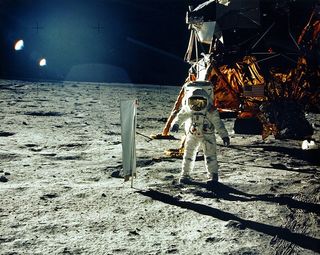
45 Years After Moon Landing, NASA is MIA (Op-Ed)

Jeff Nesbit was the director of public affairs for two prominent federal science agencies. This article was adapted from one that first appeared in U.S. News & World Report. Nesbit contributed the article to SPACE.com's Expert Voices: Op-Ed & Insights.
Oh, how so much can change in just a generation.
It was only 45 years ago — July 20, 1969 — that astronaut Neil Armstrong stepped on to the surface of the moon. It was riveting, species-changing stuff. The entire world watched every step of the journey, and hung on every word sent back to NASA mission control.
Today, just a generation later — when the United States is arguably the world's greatest superpower, capable of achieving the impossible and galvanizing world opinion with its innovation, imagination and inventiveness — NASA and the U.S. military have essentially given up on anything even close to inspiration or ambition in their space programs.
NASA's much-praised former ability to explore the edge of what we can achieve outside the confines of Earth's gravity is drifting aimlessly into space. And U.S. military leaders are more dependent on industry efforts and foreign countries for space exploration and mission capacity than they should be.
Some of the NASA engineers once involved in the space program have left to join oil-industry efforts to build sub-sea platforms on the bottom of the Arctic Ocean. The U.S. Congress has gutted NASA's space program budget, believing that the American public won't support a big, national government approach to space exploration. And perhaps most telling, the United States has outsourced its space launch-vehicle capacity to private industry and foreign countries.
It is the United Arab Emirates — yes, the small, but oil-rich, Middle Eastern nation — that is taking the next, great leap into space. UAE has just announced a plan to launch a mission to Mars within a decade. It has said it plans to land an unmanned probe on the surface of Mars by 2021.
Get the Space.com Newsletter
Breaking space news, the latest updates on rocket launches, skywatching events and more!
It is Russia that now builds the critical, core rocket engines central to the United States' national security satellite missions — which are handled by private industry, not NASA. This, by the way, has U.S. military leaders worried.
The Atlas 5 rockets of United Launch Alliance (a joint venture of Lockheed Martin and Boeing) do the heavy lifting when it comes to launching new satellites, but it's a Russian RD-180 rocket engine that gets the Atlas 5 rockets off the ground — and Russian military leaders have threatened to ban all sales of RD-180 rockets if they're used in U.S. military efforts.
If Russia balks at providing the rocket engines, it could leave the U.S. high and dry for up to four years, senior military leaders told a joint congressional hearing recently.
"If you look at what has happened to us now in the past few months, it points to a vulnerability," the head of Air Force Space Command, Gen. William Shelton, told senators in remarks that were broadcast from the July 16 hearing.
While it may have made sense to buy the advanced rocket engine from a foreign supplier for cost reasons, geopolitical considerations may force a change in that strategy for national security purposes, Shelton said.
Meanwhile, it is a private company — Space X , led by creative, risk-taking billionaire Elon Musk — that is making real plans to chart a way to Mars. At the same time, NASA sits on its hands, plays budget politics with the White House and Congress, and plans yet another series of safe, lifeless missions drifting into space.
As I described in an earlier column, Musk told the Royal Aeronautical Society in London at the end of 2012 that Space X was developing a plan to take up to 80,000 people a year to Mars in the near future and to create a large base there. Musk's other venture, Tesla, is every bit as daring as Space X — and rapidly becoming the most important entity in the highly competitive automotive industry.
So how did we get here, just 45 years after NASA put men on the moon? How is Russia more critical to our space launch-vehicle program than NASA?
Why is it that UAE and a private billionaire are trying to get to Mars — while NASA, the agency that actually could get that job done if it set its heart and mind to it, has seemingly given up any hope of space missions that could galvanize the American public the way the moon landing did in 1969?

There is a lot of blame to go around — from Republicans in Washington who hate big government solutions that include a robust NASA space program, to Democrats who have historically pulled funding from NASA's budget to support other areas, as well as presidents who have been unwilling to take the substantial risk required to authorize an actual, real push to put human beings on Mars.
But the NASA heroes of that not-so-distant past aren't dwelling on leadership and budget failures. They just want NASA to get back in the game.
NASA astronaut Edwin "Buzz" Aldrin Jr. — the second man to set foot on the moon, who says in jest that he's the first person to ever send a "selfie” back from space — has said in interviews leading up to the 45th anniversary that the NASA space program is basically nowhere and nonexistent, a shadow of its former self.
"How can you go anywhere on half a percent" of the federal budget, Aldrin said on Fox News. "Especially if you're spending [money] on things that are not going to get us anywhere?"
NASA's concept of a space program, Aldrin has said, is built around a hugely expensive design effort to get to Mars some day — a "design reference mission" that has all of the elements in one plan. Instead, Aldrin wants to encourage NASA leadership to set a goal of a permanent settlement on Mars — and then start working toward that goal in "evolutionary” steps every year starting in 2015.
Such an approach, he believes, will build momentum for NASA's efforts to revive their space program with the American public at a time when virtually no one supports the NASA space program much any more.
Whether Aldrin is right or not, one thing is crystal clear: As of right now, NASA has no real plan to inspire the public with its space program. It is living off past, heroic efforts by teams of scientists, engineers and visionaries.
The 45th anniversary of the moon landing is a bitter reminder of those very real and inspiring days of past glory — and a stark reminder of what could have been if the United States had continued to explore the edges of what the human species can achieve when it decides to pursue the seemingly impossible.
Nesbit's most recent Op-Ed was "Is it Better to Think Alone? Maybe Not." This Op-Ed was adapted from one that first appeared in Nesbit's column At the Edge in U.S. News & World Report. The views expressed are those of the author and do not necessarily reflect the views of the publisher. This version of the article was originally published on Space.com.

Join our Space Forums to keep talking space on the latest missions, night sky and more! And if you have a news tip, correction or comment, let us know at: community@space.com.
